

Psychedelics. Conscience. Gérard SabahGroupe Langage et CognitionLIMSI -- CNRS " La conscience est au psychologue ce que la gravité est au physicien : inévitable.
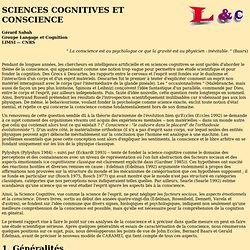
" (Baars) Pendant de longues années, les chercheurs en intelligence artificielle et en sciences cognitives se sont gardés d'aborder le thème de la conscience, qui apparaissait comme une notion trop vague pour permettre une étude scientifique et pour fonder la cognition. Des Grecs à Descartes, les rapports entre le cerveau et l'esprit sont fondés sur le dualisme et l'interaction d'un corps et d'un esprit matériels.
Descartes fut le premier à tenter d'expliciter comment un esprit non matériel interagissait avec le corps (par l'intermédiaire de la glande pinéale). Les " occasionnalistes " (Malebranche, mais aussi de façon un peu plus lointaine, Spinoza et Leibniz) conçoivent l'idée fantastique d'un parallèle, commandé par Dieu, entre le corps et l'esprit, par ailleurs indépendants. 1.1. 1.2. . * Sélectivité. . * Exclusivité. The 8-Circuit Model of Consciousness. I. The Terrestrial Circuits 1. The Biosurvival Circuit: imprinted in infancy. Concerned with sucking, nourishment, cuddling, biosecurity. 2. Imprinted in the toddling stage. 3. Imprinted by human artifacts and symbol systems. Consciousness. Damasio defines consciousness as “the sense of self in the act of knowing . . . a narrative without words” (Damasio, 2000, p. 168), with characters – the organism (us) and the object (everything we encounter) – unfolding in time.
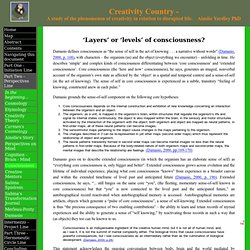
He describes ‘simple’ and complex kinds of consciousness differentiating between ‘core consciousness’ and ‘extended consciousness’. Core consciousness (the ‘here and now’ consciousness), he says, generates an imaged, nonverbal account of the organism’s own state as affected by the ‘object’ in a spatial and temporal context and a sense-of-self (in the act of knowing). The sense of self in core consciousness is experienced as a subtle, transitory “feeling of knowing, constructed anew in each pulse.” Damasio grounds the sense-of-self component on the following core hypotheses:
Extended consciousness. Developed in his (1999) book, 'The Feeling of What Happens', Antonio Damasio's three layered theory of consciousness is based on a hierarchy of stages, with each stage building upon the last.
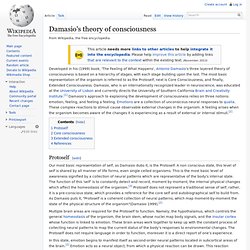
The most basic representation of the organism is referred to as the Protoself, next is Core Consciousness, and finally, Extended Consciousness. Damasio, who is an internationally recognized leader in neuroscience, was educated at the University of Lisbon and currently directs the University of Southern California Brain and Creativity Institute.[1] Damasio's approach to explaining the development of consciousness relies on three notions: emotion, feeling, and feeling a feeling. Emotions are a collection of unconsicous neural responses to qualia. These complex reactions to stimuli cause observable external changes in the organism. A feeling arises when the organism becomes aware of the changes it is experiencing as a result of external or internal stimuli.[2] Protoself[edit]
Profile on TED.com. Web resources on consciousness, philosophy, and such. Web resources related to consciousness, philosophy, and such.
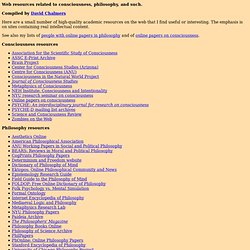
Compiled by David Chalmers Here are a small number of high-quality academic resources on the web that I find useful or interesting. The emphasis is on sites containing real intellectual content. See also my lists of people with online papers in philosophy and of online papers on consciousness. Mirror neuron. A mirror neuron is a neuron that fires both when an animal acts and when the animal observes the same action performed by another.[1][2][3] Thus, the neuron "mirrors" the behavior of the other, as though the observer were itself acting.
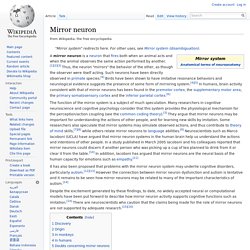
Such neurons have been directly observed in primate species.[4] Birds have been shown to have imitative resonance behaviors and neurological evidence suggests the presence of some form of mirroring system.[4][5] In humans, brain activity consistent with that of mirror neurons has been found in the premotor cortex, the supplementary motor area, the primary somatosensory cortex and the inferior parietal cortex.[6] The function of the mirror system is a subject of much speculation.
Discovery[edit] Further experiments confirmed that about 10% of neurons in the monkey inferior frontal and inferior parietal cortex have "mirror" properties and give similar responses to performed hand actions and observed actions. Origin[edit] In monkeys[edit] In humans[edit]